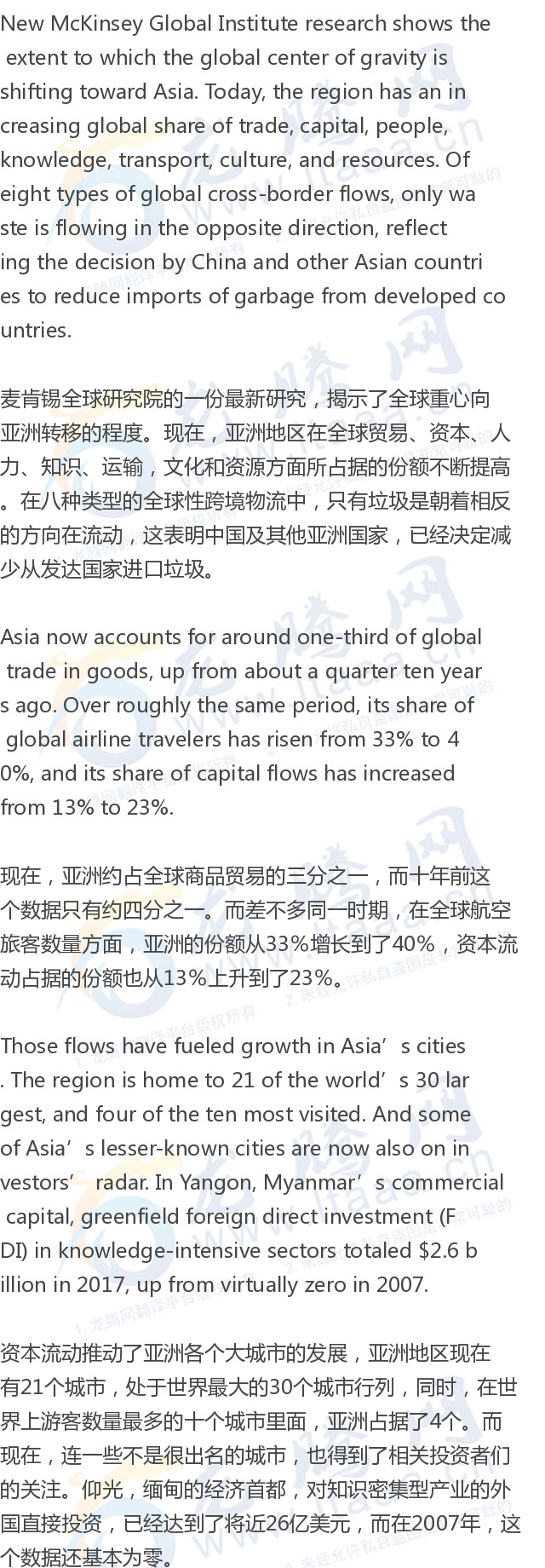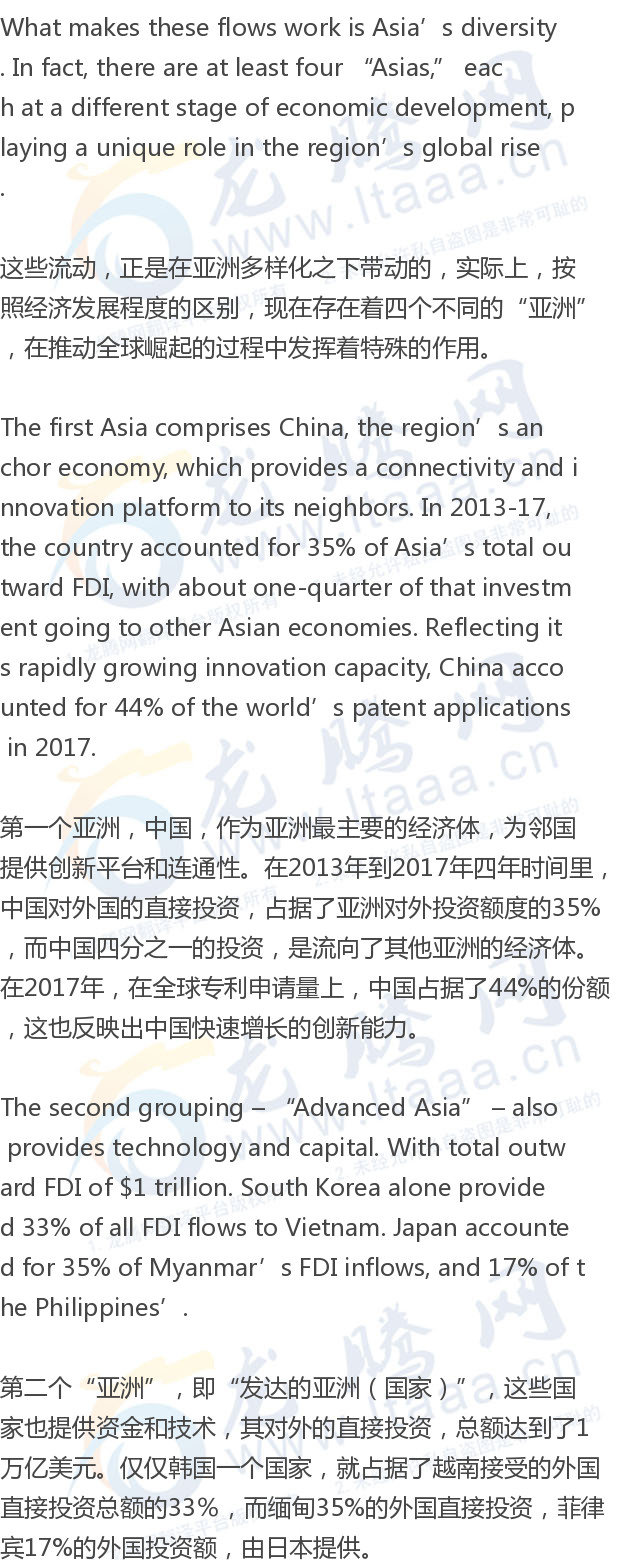 亚洲世纪已经来了
亚洲世纪已经来了
正文翻译
原创翻译:龙腾网 http://www.ltaaa.com 翻译:squart 转载请注明出处

SHANGHAI – In the nineteenth century, the world was Europeanized. In the twentieth century, it was Americanized. Now, it is being Asianized – and much faster than you may think.
(上海)十九世纪,世界是欧洲化的,到了二十世纪,它又被美国化了,而如今,它正在被亚洲化——并且其速度要比你想象的要快得多。
Asia’s rise has been swift. Home to more than half of the world’s population, the region has climbed from low- to middle-income status within a single generation. By 2040, it is likely to generate more than 50% of world GDP, and could account for nearly 40% of global consumption.
亚洲的崛起非常迅速,作为全球半数以上人口的家,它们在一代人的时间里,就将该地区从中低收入水平提升到了中等收入水平。到2040年,亚洲可能为世界贡献超过一半的GDP,并可能占据消费全球的40%。

Similarly, Bekasi, a smaller city near Jakarta, has emerged as the Detroit of Indonesia – the center of Indonesia’s automotive and motorcycle industry. Over the last decade, FDI in the city’s manufacturing industry has grown at an average rate of 29% per year. And Hyderabad – which generated over 1,400 patents in 2017 – is quickly catching up with India’s Silicon Valley, Bangalore.
类似的,印尼雅加达周边的小城市勿加泗,已经变成了印度尼西亚的底特律——印度尼西亚汽车和摩托制造业的中心。过去十年时间里,这个城市接收到的外国直接投资,每年平均增长速度达到了29%。而海得拉巴,这个印度城市在2017年新获取了1400多项专利,正在快速追赶印度的“硅谷”班加罗尔。
But it’s not only external flows being channeled into Asia. Dynamic intraregional networks are also driving progress. Around 60% of Asian countries’ total trade in goods occurs within the region, facilitated by increasingly integrated Asian supply chains. Intraregional funding and investment flows are also increasing, with more than 70% of Asian startup funding coming from within the region. Flows of people – 74% of travel within Asia is undertaken by Asians – help to integrate the region as well.
不仅仅外面的资金不断进入亚洲,亚洲内部的活力也在推动亚洲的进步,在供应链渐渐一体化的作用下,约有六成的商品贸易活动发生在亚洲国家内部,地区内融资和投资规模都在扩大,七成的初创企业资金来源于亚洲内部,人口流动也有助于该地区的一体化(区域内74%的人员流动是亚洲人自己产生的)。

Then there is “Emerging Asia,” which comprises a relatively diverse group of small emerging economies that provide not only labor, but also growth potential, owing to rising productivity and consumption. These economies are deeply integrated with their regional neighbors: their average share of intraregional flows of goods, capital, and people is 79%, the highest of the four Asias.
接下来是 “新兴的亚洲(国家)”,其中包括相对小型的新兴经济体,在这些国家,生产力和消费的增长,使得这些国家不仅提供劳动力,而且还提供增长的潜力。这些经济体与亚洲领国之间深度融合:它们占据亚洲内部商品、资本和人员流动的份额达到了79%,这是四个不同的“亚洲”中,占据的最高份额。
By contrast, the fourth grouping – “Frontier Asia and India” – has the lowest average share of intraregional flows, amounting to just 31%. But this figure – which reflects historic ties to Europe, the Middle East and Africa, and the United States – is set to increase, as these economies, which historically were less integrated, forge closer bonds with their Asian neighbors. This group has a lot to offer, including a relatively young labor force that is capitalizing on the growing Asian import market, and a growing middle class that can serve as a new market for regional exports.
相比之下,第四个亚洲,即“外围亚洲和印度”,在区域内流动中的平均份额最低,仅仅只有31%,但随着这些在历史上对亚洲融入程度较低的国家能够加强与邻居们的关系,这个数据应该会有所增长。这些国家可以提供很多东西:包括不断增长的亚洲进口市场所需的、相对年轻的劳动力,同时这些国家迅速增长的中产阶级群体能够为亚洲出口商提供新的市场。

For years, observers have breathlessly discussed Asia’s future potential. The future has arrived. We have entered the “Asian century,” as the author Parag Khanna puts it. There is no turning back.
这么些年来,观察家们一直在探讨未来亚洲不可估量的潜力,现在,这样的未来已经到来了。就和著名作家帕拉格说的那样,我们已经进入了“亚洲世纪”,而且一旦进入,就不再回头。
原创翻译:龙腾网 http://www.ltaaa.com 翻译:squart 转载请注明出处

SHANGHAI – In the nineteenth century, the world was Europeanized. In the twentieth century, it was Americanized. Now, it is being Asianized – and much faster than you may think.
(上海)十九世纪,世界是欧洲化的,到了二十世纪,它又被美国化了,而如今,它正在被亚洲化——并且其速度要比你想象的要快得多。
Asia’s rise has been swift. Home to more than half of the world’s population, the region has climbed from low- to middle-income status within a single generation. By 2040, it is likely to generate more than 50% of world GDP, and could account for nearly 40% of global consumption.
亚洲的崛起非常迅速,作为全球半数以上人口的家,它们在一代人的时间里,就将该地区从中低收入水平提升到了中等收入水平。到2040年,亚洲可能为世界贡献超过一半的GDP,并可能占据消费全球的40%。

Similarly, Bekasi, a smaller city near Jakarta, has emerged as the Detroit of Indonesia – the center of Indonesia’s automotive and motorcycle industry. Over the last decade, FDI in the city’s manufacturing industry has grown at an average rate of 29% per year. And Hyderabad – which generated over 1,400 patents in 2017 – is quickly catching up with India’s Silicon Valley, Bangalore.
类似的,印尼雅加达周边的小城市勿加泗,已经变成了印度尼西亚的底特律——印度尼西亚汽车和摩托制造业的中心。过去十年时间里,这个城市接收到的外国直接投资,每年平均增长速度达到了29%。而海得拉巴,这个印度城市在2017年新获取了1400多项专利,正在快速追赶印度的“硅谷”班加罗尔。
But it’s not only external flows being channeled into Asia. Dynamic intraregional networks are also driving progress. Around 60% of Asian countries’ total trade in goods occurs within the region, facilitated by increasingly integrated Asian supply chains. Intraregional funding and investment flows are also increasing, with more than 70% of Asian startup funding coming from within the region. Flows of people – 74% of travel within Asia is undertaken by Asians – help to integrate the region as well.
不仅仅外面的资金不断进入亚洲,亚洲内部的活力也在推动亚洲的进步,在供应链渐渐一体化的作用下,约有六成的商品贸易活动发生在亚洲国家内部,地区内融资和投资规模都在扩大,七成的初创企业资金来源于亚洲内部,人口流动也有助于该地区的一体化(区域内74%的人员流动是亚洲人自己产生的)。

Then there is “Emerging Asia,” which comprises a relatively diverse group of small emerging economies that provide not only labor, but also growth potential, owing to rising productivity and consumption. These economies are deeply integrated with their regional neighbors: their average share of intraregional flows of goods, capital, and people is 79%, the highest of the four Asias.
接下来是 “新兴的亚洲(国家)”,其中包括相对小型的新兴经济体,在这些国家,生产力和消费的增长,使得这些国家不仅提供劳动力,而且还提供增长的潜力。这些经济体与亚洲领国之间深度融合:它们占据亚洲内部商品、资本和人员流动的份额达到了79%,这是四个不同的“亚洲”中,占据的最高份额。
By contrast, the fourth grouping – “Frontier Asia and India” – has the lowest average share of intraregional flows, amounting to just 31%. But this figure – which reflects historic ties to Europe, the Middle East and Africa, and the United States – is set to increase, as these economies, which historically were less integrated, forge closer bonds with their Asian neighbors. This group has a lot to offer, including a relatively young labor force that is capitalizing on the growing Asian import market, and a growing middle class that can serve as a new market for regional exports.
相比之下,第四个亚洲,即“外围亚洲和印度”,在区域内流动中的平均份额最低,仅仅只有31%,但随着这些在历史上对亚洲融入程度较低的国家能够加强与邻居们的关系,这个数据应该会有所增长。这些国家可以提供很多东西:包括不断增长的亚洲进口市场所需的、相对年轻的劳动力,同时这些国家迅速增长的中产阶级群体能够为亚洲出口商提供新的市场。

For years, observers have breathlessly discussed Asia’s future potential. The future has arrived. We have entered the “Asian century,” as the author Parag Khanna puts it. There is no turning back.
这么些年来,观察家们一直在探讨未来亚洲不可估量的潜力,现在,这样的未来已经到来了。就和著名作家帕拉格说的那样,我们已经进入了“亚洲世纪”,而且一旦进入,就不再回头。
评论翻译
很赞 4
收藏